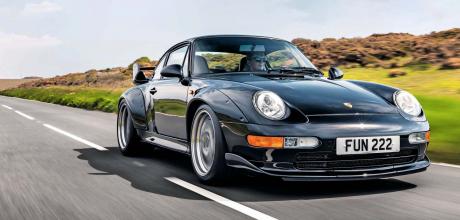1995 Porsche 911GT 993
The 430bhp bi-turbo 1995 911GT was Porsche’s last air-cooled hurrah. Does this fearsome machine deserve its Widowmaker reputation? Words: Emma Woodcock. Photography: Jonathan Fleetwood.
Breathtaking Foot to the floor in the little-known, race-bred Nineties 993 Porsche 911GT
Full boost hits and the 1995 Porsche 911GT sends the full impact of 0.9 bar to the rear wheels, and the rear wheels alone. The 285-section rear tyres squirm, threatening to swerve the distorted, riveted wheel arches across the road, and all I can do is keep my right foot pressed hard down. The 993 GT2 – as it’s more commonly but less accurately known – has a reputation. Mixing the twin-turbocharged engine from a contemporary 911 Turbo with the thin glass and skeletal interior of a 911 Carrera RS, while equipping the driver with nothing more than ABS and power-assisted steering to fight their corner, the 430bhp GT is The Widowmaker.
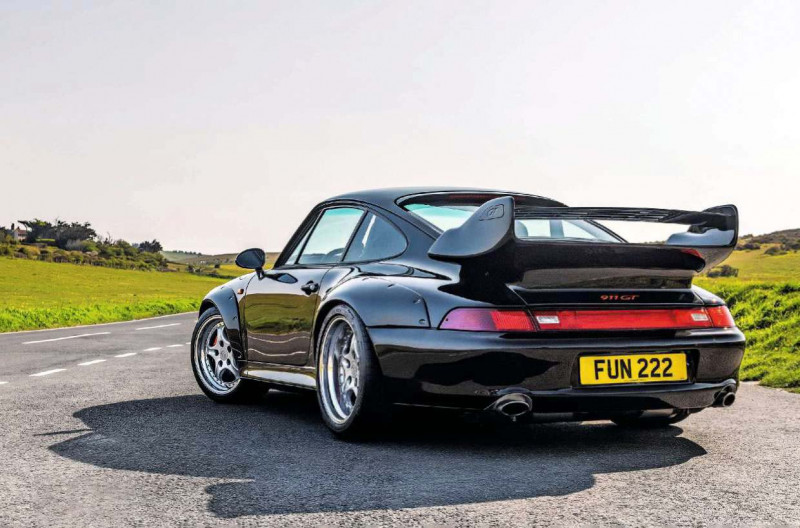
Is the 993 GT2 the ultimate 911?

With 430 aircooled horses, isthe 993 GT peak Porsche
Porsche switched to water cooling two years after the GT was introduced. It would never build a faster air-cooled production car nor would it construct another rear-engined machine with such naked competition focus. The 911GT exists solely to homologate the GT2R sports racing car, giving privateer teams rules-compliant access to twin KKK K24 turbochargers, a full glassfibre Aerokit with an adjustable bi-plane rear wing and an extended track some 120mm wider than a standard 993 Carrera.
‘It out-punched the Lamborghini Diablo SV and could hold its own against the Bugatti EB110’
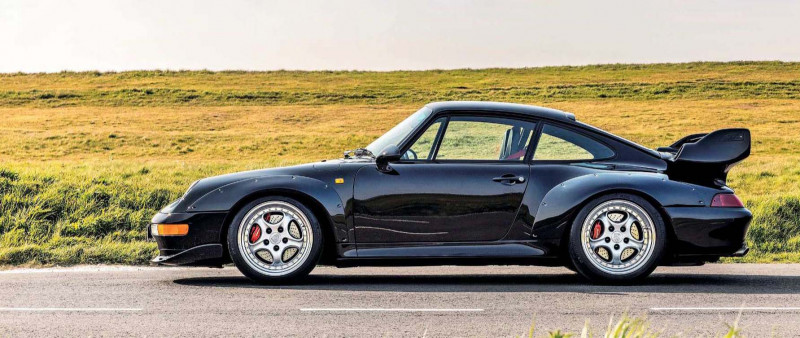
A total of 193 road cars share this specification. They boast 339bhp per ton and hit 60mph in 3.9 seconds, out-punching the Lamborghini Diablo SV and holding their own against the Bugatti EB110. Nothing else at the GT’s £130,000 price point could keep up; even its 996 GT2 successor accelerates no faster. The rear axle snakes in a tight, hard ricochet as the 3.6-litre engine ignites. The 911GT lunges forwards, pulsing through its 398lb ft peak torque in a blink and charging through 5000rpm. I see the rev-counter spin furiously and hear the turbo intakes flood static into the cabin, swelling into a fuzzy clamour that drowns out the engine. The car accelerates harder still, squatting down into the 11-inch wide rear wheels and re-discovering its voice as the revs charge towards the 5750rpm power peak. The sound is dry and hard, led by the air intakes far behind my head. It shifts again as the revs spiral upwards, shedding its serrated edge to emerge hollow, high-pitched and nearly digital. I can’t pause to enjoy it. The nine-inch front alloy wheels are darting between cambers, pulling the Porsche across the road in concise, distracted sniffs that tug the steering wheel off line and only grow more intense when I try to lock my wrists in place. I loosen my grip then feel the nose bob in a fast patter as it mounts a crest and shoulders down into the compression below. Short, sharp feedback crackles through my hips, hands and feet but the Porsche never stops accelerating.
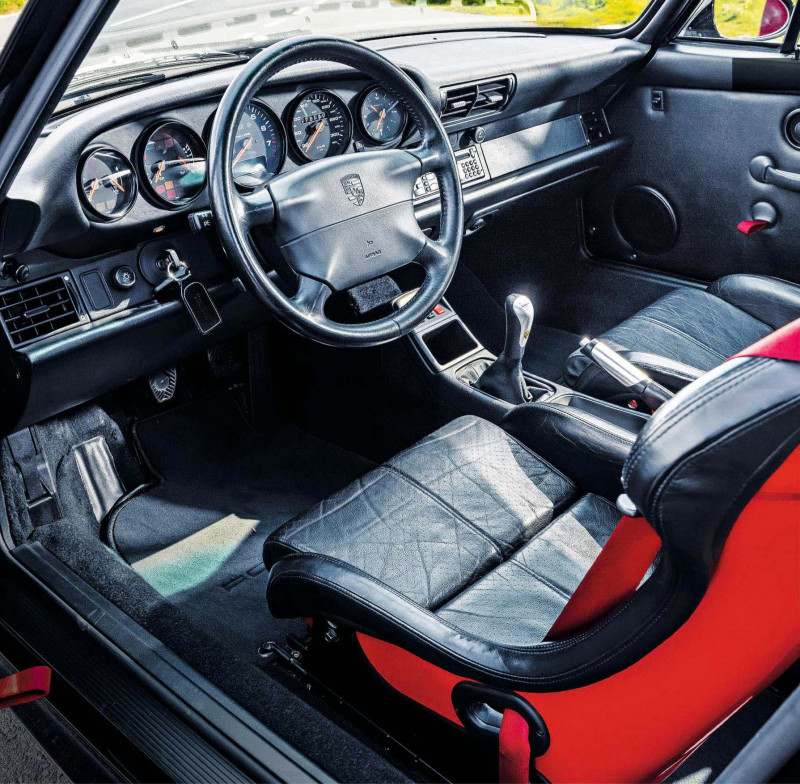
I release the floor-mounted throttle pedal as the redline approaches, pausing the crescendo just for a moment. The clutch traces its light, indistinct travel to the release point, the gear lever snicks quickly through its long yet tightly defined travel and the Porsche drops back to the beginning of the cycle, filling its lungs as it charges forwards again. Then it hits me. The rear wheels only yaw to the first blow of full boost then settle down and take everything I can throw at them from 4500rpm. I’m focused on the front wheels but rear traction is unimpeachable, at least on a warm, sunny day. The black widow isn’t biting.
Dropping to a steady speed reveals a capable cruiser. Firm bushes and short springs restrict body movement but the GT rides with composure, sloughing away the worst edges of the road below to send edited and precise reports up through my spine. The driving position is equally assured, sitting me higher and more upright than a Lotus Esprit Sport 350 or Ferrari F355. Close ahead stands the airbag-equipped four-spoke steering wheel with the upright windscreen just beyond. The pedals stretch further forwards but bite progressively at low speed; the five dials dead ahead hark back to the very first 911s; the engine fires with a loud but dulled, percussive burr below 3000rpm.
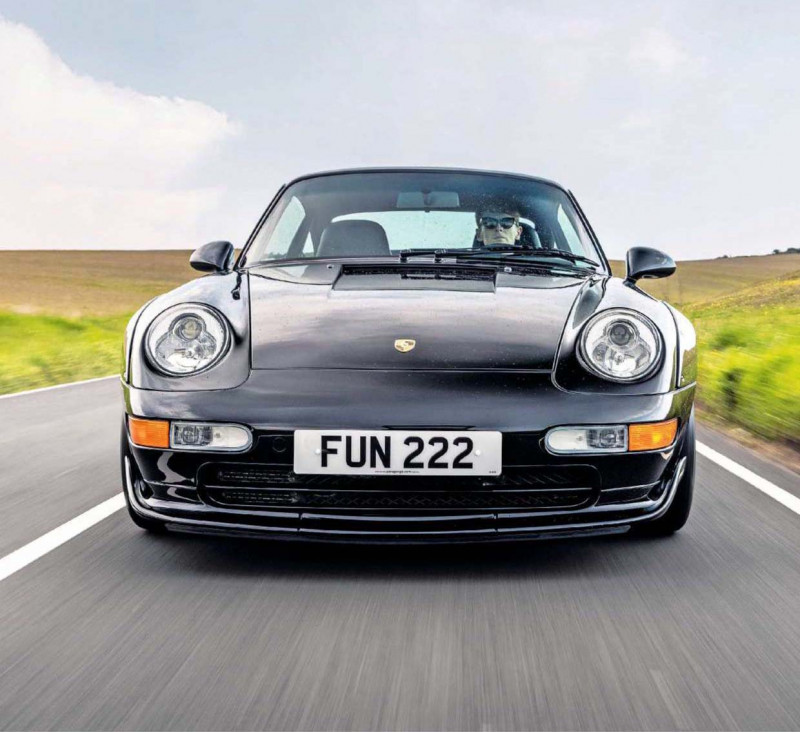
Only the stripped-back interior reminds me that I’m in a would-be competition car. Porsche applied the same weightsaving regime it used for the naturally-aspirated Carrera RS to the 911GT so neither has the standard Carrera’s rear bench seat, central locking, electric mirrors or much of the sound deadening. Simplified door cards with fabric door pulls continue the diet, though the radio, airbags and electric windows could be reinstated for no extra cost. This car features all three, alongside the optional fixed-back Recaro bucket seats. Channelling my thighs tight between high glassfibre sides and clutching at my ribcage – while keeping my shoulders free – the chair underlines the Porsche’s track-ready intent.
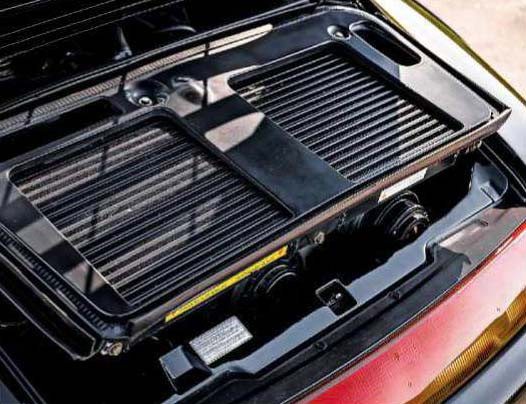
So do the glassfibre Aerokit bodykit panels. Yorkshireman Tony Hatter was tasked with styling the new look, allowing for racing requirements while he built on the basic 993-generation 911 shape that he’d penned four years earlier. He added an upswept front apron, deep side skirts and a fixed rear wing with integrated air intakes. The Formula One-style devices are ducted straight to the turbochargers on GT2R racers; they cool the entire engine bay on 911GT road cars. Yet more striking are the wheelarch extensions; riveted in place to facilitate trackside replacement, they stretch 1850mm over the rear axle.
The mechanical specification blends together high-performance parts from other Porsches. Borrowing again from the Carrera RS, the 911GT employs shorter springs, solid suspension bushes and revised front axle kinematics to sharpen the handling, while adjustable anti-roll bars front and rear allow owners to tailor the car’s cornering responses to their preference. Lightweight glazing, aluminium doors and an aluminium bonnet are also carried over from the RS.
Powertrain components are adapted from the all-wheel-drive 911 Turbo; the GT uses the same M64/60 engine but a redesigned ECU and 0.1 bar increase in maximum turbo pressure produce an extra 22bhp. The homologation model’s G50/53 six-speed transaxle places the Turbo gears, final drive and plate-type limited-slip differential in a rear-wheel-drive application. A unique ZMS dual mass flywheel completes the driveline. The 911GT entered production in early 1995 and motor sport success was instant. The GT2R took its first class victory in the Jerez Four Hours that February, followed by a premiere overall win at an ADAC GT Cup race in April. Homologated for the revised GT2 category in January 1996, the GT2R stormed that year’s BPR Global GT Series and took a one-two LM-GT2 class finish at the 1996 24 Hours of Le Mans.
Road car production was a similar if smaller success. Offered in basic M002, stripped-out M003 Clubsport and later more powerful EVO specifications, the 911GT spanned two production years and vastly outsold Porsche’s initial 40 unit sales target. I’m sitting in one of the first, a German-delivered M002 that left the production line on 25 April 1995 and met its first owner at Porsche Zentrum Düsseldorf on 18 May the same year. Several 911GTs have been crashed, modified or used on track, yet this A1 Black machine escaped such fates as it accumulated 17,000km over the next 17 years. Its first owner sold it to a German collector who added a further 800km before trading it into Switzerland in 2017. Its third owner never drove or registered it but had it serviced regularly by collector-grade Porsche specialist Maxted-Page in Essex.
Managing director Lee Maxted-Page oversaw its 2020 trade to current owner Mark Sumpter during the first coronavirus lockdown. Mark – founder of East Sussex dealership Paragon Porsche – has driven every 911 of note but never owned a 911GT before and plans to drive it extensively in the UK and Europe. Freed from my initial preconceptions, I point the GT towards fast jinks and switchbacks. The power still feels ludicrous but the lightweight multi-link rear suspension – introduced by the 993 to tame the 911’s spiky handling – glues the tyres to the road, working with coil springs to reduce the threat of roll oversteer. Turbo-sourced 322mm brake discs and four-piston ‘Big Red’ calipers add further confidence, shedding speed with a certainty that mimics a track-biased Lotus Exige more than a Lamborghini or Aston Martin. Screaming towards the first hairpin, I push the middle pedal and it arcs through a short, light dead zone before biting instantly. A high-pitched whinny echoes from the front discs but the pedal is short and hard now, creating the perfect platform for heel-and-toe downshifts. I drop down to second and the Porsche whoops, the tacho flicking past 4500rpm.
I throw more weight into the middle pedal and the GT responds, letting me adjust its attitude with pressure more than movement. The wheel is quiet in my hands, the chassis tracking dead straight. It feels more like a competition machine than a Nineties supercar. Still mindful of the rearward weight distribution I release the brakes and turn hard, expecting the Porsche to turn with the same conviction. It doesn’t, quite. The power-assisted steering is still fizzing back messages about the road surface but the wheel is light between my hands and the nose responds with a gentle, shallow arc.
A downhill straight blurs past in a riot of boost and just-about-gripping rear tyres. I brake again but have learned my lesson, this time bleeding slowly off the pedal as I enter the corner in an attempt to keep weight over the front wheels. The Porsche replies with more steering weight and pinpoint accuracy from calm front wheels. Now the slightest shift in steering lock changes the trajectory, giving the 911GT an agility that a Nineties driver would need a Mitsubishi Lancer Evolution VI and its novel Active Yaw Control system to match.
I lean gradually back into the power as the apex approaches; the steering pulls at my wrists but the back wheels feel secure so I push past half throttle and feel the Porsche lean into its outside rear tyre. The revs pass 4000rpm and I slingshot out of the turn with absolute traction, ripping through second and hearing the wastegates sneeze as they dump boost when I shift into third. I breathe in a cocktail of dull hot metal, brake pads and engine oil and catch a whiff of tyre rubber and part-burned petrol.
As the last air-cooled Porsche built purely for competition, it completes a story that the 1972 Carrera RS2.7 started and drives with a focus that Italian supercars of the same era can’t match. And yet it retains a generous operating window, in direct contradiction to its fearsome reputation. It handles day-to-day driving like any other 993 then delivers unforgettable thrills when I try a little harder, establishing a formula that Porsche has refined over four generations of water-cooled GT2s and GT3s. It’s not difficult to see why – pinning the nose into one final jink and unleashing the throttle until the rear tyres squirm, the GT crackles with energy but never feels scary.
Less Widowmaker, more thrill-seeker.
The GT represents one of the most aggressive visual departures from the base shape in the 911’s history
TECHNICAL DATA FILE 1995 Porsche 911GT 993
- Engine 3600cc horizontally-opposed six-cylinder, twin turbochargers, SOHC, Bosch Motronic M 5.2 electronic fuel injection, twin KKK K24 turbochargers
- Power and torque 430bhp @ 5750rpm; 398lb ft @ 4500rpm
- Steering Rack-and-pinion, power-assisted
- Suspension Front: independent, MacPherson struts, coil springs, hydraulic dampers, anti-roll bar. Rear: independent, multi-link, coil
- springs, hydraulic dampers, anti-roll bar
- Brakes Servo-assisted, ABS. Front and rear: cross-drilled and ventilated discs
- Performance Top speed: 184mph; 0-60mph: 3.9sec
- Weight 1290kg (2844lb)
- Fuel consumption 16.3mpg
- Cost new £130,000
- Classic Cars Price Guide £900,000-£1,800,000
Driving position will be familiar to any air-cooled Porsche 911 motorist. 430bhp bi-turbo engine uses charge cooling Tachometer sits dead centre, just like a race car 322mm discs and Big Red calipers donated by related 993 Turbo
‘Channelling my thighs tight between high glassfibre sides and clutching at my ribcage, the chair underlines the car’s track-ready intent’
Fixed-back Recaros dominate cabin… you could spec adjustable sports seats instead 911GT spawned an EVO variant with 450bhp that was even faster Integral rear wing vents send cold air straight into intercooler Braking performance is prodigeous but front pads are squeaky Note absence of the numeral on the end of the model name.
Seven arch rivets up front, eight at the rear; one bona fide legend
OWNING A PORSCHE 911GT
Mark Sumpter has been trading Porsches since 1993. He still remembers when the 911GT was launched. ‘I was completely awestruck’ he chuckles. ‘I did a few seasons of British GT racing later in its lifecycle and I still remember them passing me on track. I love that heritage and how the model was built to go racing.
‘My GT had hardly been used in a decade so I gave it were a thorough service and a new set of Michelin Pilot Sport tyres, which cost around £1000 for the set. I’ve replaced the door speakers, too – they’d gone hard – and I might fit a new clutch and flywheel soon. They’re both original and produce a little backlash.
‘I hadn’t been looking for a 911GT but this one felt very comfortable as soon as I sat in it. It’s exhilarating to drive – it rips through second, third and fourth – but I really value its usability, too. It never overheats, it’s docile in traffic and there’s plenty of space for soft bags. I’m going to drive it to race meetings all over Europe this year. I can’t wait!’


